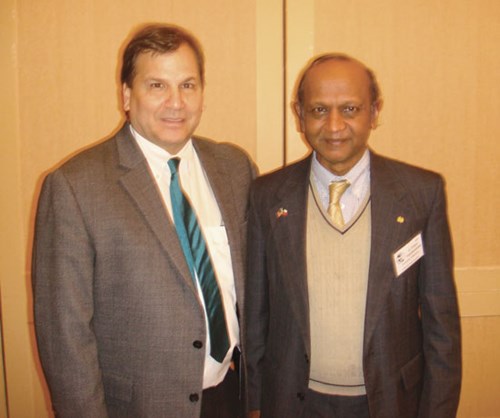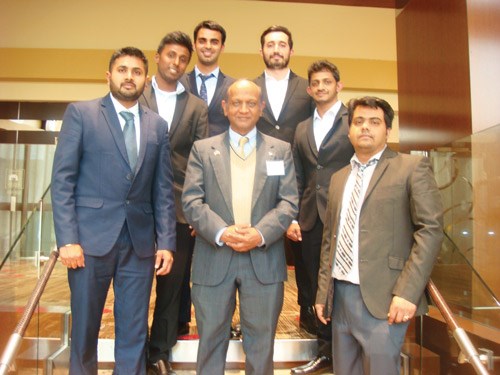May 2019 Vol. 74 No. 5
Features
CIGMAT 2019 Addresses Multitude of Infrastructure Issues
The 24th annual, one-day CIGMAT Conference and Exhibition was organized by the Center for Innovative Grouting Materials and Technology (CIGMAT) and the Department of Civil and Environmental Engineering, University of Houston, and held at the University Hilton, University of Houston on March 1. More than 270 attendees representing owners, consulting engineers, material suppliers, contractors and academia plus 14 speakers participated in the event, titled “Infrastructure, Energy, Geotechnical, Flooding and Sustainable Issues Related to Houston and Other Major Cities.”
In his initial, welcome remarks, Professor C. Vipulanandan, director of CIGMAT and the Texas Hurricane Center for Innovative Technology (THC-IT), explained the need for such a conference by highlighting major cities experiencing rapid growth in population and economic activities, with changing conditions and regulations.
Houston, as the energy capital of the United States and with the largest medical center in the world, has an ever-increasing need for expanding the infrastructures, meeting the energy demand and integrating the advances in technologies to meet the population growth and industrial expansion with the impact of natural disasters.
General Session
The General Session focused on expanding highway transportation infrastructures, innovative solutions for public works and energy needs around the world for the next several decades.
Texas Department of Transportation’s Larry Blackburn, director of Design, and Varuna Singh, director of Alternative Delivery Program, discussed some of the major projects in the greater Houston area that will be completed next year, and several ongoing and new highway projects valued at more than several billions of dollars that will start in the next few years. Houston is ranked very high nationally in traffic congestion problems at some locations and plans are underway to overcome these problems. They also discussed topics related to environmental issues, maintenance and funding for the department of transportation.
Michael Ereti, director of Capital Projects from the City of Houston Public works discussed recent updates on construction management programs, debris management and challenges after hurricane Harvey (August 2017), as well as new plans for continuing various city of Houston operations with the growing population.
Liana Alvarez, advisor for Sustainable Procurement at ExxonMobil, discussed the changing trends in energy needs around the world. Increased needs are not only due to growth of industries but also growth of the middle-class population around the world, especially in Asia. The presentation not only focused on the growing demand for oil and gas, but also the growth of solar energy and wind energy production around the world.
In addition, four technical sessions highlighted the growth, challenges and changes faced in major cities.
Flooding, construction issues
The first session was a panel discussion on “Flooding and Construction Issues” moderated by Rafael Ortega from Aurora Technical Services, Houston. Panelists included Atul Hannan, director of planning at Harris County Flood Control, who discussed new methodologies and technologies that are providing a more complete understanding of flood risks throughout Harris County.
The ongoing project targets updates for more than 2,500 miles in 22 watersheds across Harris County with multi-year assessments using new rainfall frequency data, updated terrain data, and improved hydrologic and hydraulic modeling technology and methods. The goal is to enable the public, local communities and emergency managers to make informed decisions to protect life and property during flood events.
Ivan Langford, general manager of Gulf Coast Water Authority, discussed some of the major challenges in meeting the industrial water demand in the region. These include growth of industries in both diversity and volume, and the limitation of water resources.
Wayne Ahrens, director of engineering at Dannenbaum, covered the challenges in constructing large-diameter water pipelines (LDWL) in urban environments such as Houston. Issues such as routing, easement acquisition, design, construction and public perception associated with LDWL are some of the important parameters to consider, as well as existing infrastructure and structures that may be impacted by the construction. There are many street/road crossings and the difficult decisions lie in determining which ones can be open cut versus tunneled and how to maintain traffic if they are open cut. Also, of concern are multiple crossings of major highways and drainage features.
Water and wastewater
The third session, “Water and Wastewater Issues” was moderated by Mackrena Ramos of Lockwood, Andrews and Newnam (LAN) Inc.
Jeff Haby, vice president of the San Antonio Water System (SAWS), provided background and history of the SAWS Wastewater Collection and Treatment systems, and key considerations, phases, lessons learned and program effectiveness during the Sanitary Sewer Overflow (SSO) Consent Decree (CD) process.
More than 40 cities in the U.S. are addressing SSOs as part of a consent decree. These comprehensive programs require both operation and maintenance, as well as capital investment. SAWS has reduced SSOs by more than 60 percent since 2010, and its CIPs for the next five years total over $2.3 billion.
San Antonio, the seventh largest city in the nation, has 12,500 miles of pipelines, 100,000 manholes, 73 water pump stations, 191 wells and 117storage tanks. SAWS also has153 lift stations and four treatment plants.
Bill Schlafe, LAN, talked about expanding facilities at the Conroe Central Wastewater Treatment Plant. As one of the fastest growing cities in the U.S., Conroe must balance population growth and widely varying economic activities with its wastewater treatment needs.
Brain Gettinger, project manager-/tunneling service leader at Freese and Nichols, discussed the Flood Tunnel-A Solution to Houston’s Stormwater Conveyance Problem. Hurricane Harvey caused catastrophic flooding across Houston in August 2017, adding it was not a once-in-a-lifetime event. Tax Day 2016, Memorial Day 2015, and other storms have also resulted in severe flooding conditions across the metro area.
As the city grows, the ability to detain and convey stormwater at the surface has become more challenging. Tunneling is a solution that has not been considered before but should be evaluated for all future flood conveyance projects, large and small in Houston, particularly where urban, environmental and community constraints are significant.
Based on similar large-diameter, soft ground tunnels built or under construction in the nation, an early cost estimate is $100 million per mile for a 30 to 40-foot-diameter tunnel. Therefore, a tunnel from the reservoirs to the Ship Channel—exceeding 20 miles in length—represents a significant investment of more than $2 billion.
Smart cement
C. Vipulanandan presented on “Smart Cement for Concrete and Repairing Grout Applications with Real-Time Monitoring and Characterized Using Vipulanandan Models.” Cement-based concrete and grouts are used in the construction, maintenance and repairing of onshore and offshore infrastructures. In order to ensure safety and extend the service life of these infrastructures, it is important to monitor the changes in the construction and repair materials with the varying environments. Recently, chemo-thermo-piezoresistive smart cement, a highly sensing cement, was developed and its potential application in concrete and cement grouts to make these materials highly sensing is being considered.
In this study, the behavior of concrete and grout made using the piezoresisitive smart cement was investigated to test and model the bulk sensing properties. The coarse aggregate content in the concrete was 75 percent (by volume). The grout was prepared using water-to-cement (w/c) ratio of 0.8. The concrete and grout property changes during curing were monitored using electrical resistivity, since it can be easily adopted for real-time monitoring.
Smart grout with piezoresistive behavior was developed using the smart cement with water-to-cement ratio of 0.8. The piezoresistivity smart cement with 75-percent aggregate made the concrete highly piezoresistive and the resistivity increased with applied compressive stress. Also, the smart cement made the grout to be piezoresisitive.
The piezoresisitive behavior of the concrete and grout with smart cement were modeled using the Vipulanandan p-q curing and piezoresistivity model. Based on the coefficient of determination (R2) and root mean square error (RMSE), Vipulanandan models predicted the experimental results very well.
A reception followed the technical sessions in the exhibit area where there were posters on research activities at CIGMAT and in the Department of Civil and Environmental Engineering.
CIGMAT 2019 Conference Proceedings are posted on the CIGMAT website: cigmat.cive.uh.edu. The next CIGMAT conference (CIGMAT 2020) will be held on March 6, 2020, at the University Hilton, University of Houston. •






Comments